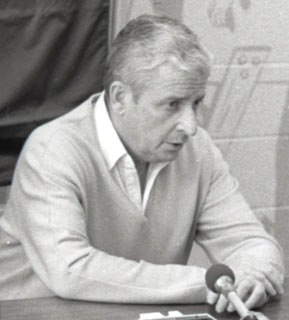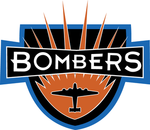
The Baltimore Ravens are a professional American football team based in Baltimore. The Ravens compete in the National Football League (NFL) as a member of the American Football Conference (AFC) North division. The team plays its home games at M&T Bank Stadium and is headquartered in Owings Mills, Maryland.

The Cleveland Browns are a professional American football team based in Cleveland. Named after original coach and co-founder Paul Brown, they compete in the National Football League (NFL) as a member club of the American Football Conference (AFC) North division. The Browns play their home games at Cleveland Browns Stadium, which opened in 1999, with administrative offices and training facilities in Berea, Ohio. The Browns' official club colors are brown, orange, and white. They are unique among the 32 member franchises of the NFL in that they do not have a logo on their helmets.

The Montreal Alouettes are a professional Canadian football team based in Montreal, Quebec. Founded in 1946, the team has folded and been revived twice. The Alouettes compete in the East Division of the Canadian Football League (CFL) and last won the Grey Cup championship in 2010. Their home field is Percival Molson Memorial Stadium for the regular season and as of 2014 also home of their playoff games.

The Baltimore Stallions were a Canadian Football League team based in Baltimore, Maryland, in the United States, which played the 1994 and 1995 seasons. They were the most successful American team in the CFL's generally ill-fated southern expansion effort into the United States, and by at least one account, the most winning expansion team in North American professional sports history at the time. They had winning records in each season, and in both years advanced to the championship game. In 1995, they became the only American franchise to win the Grey Cup.
The San Antonio Texans were a Canadian Football League (CFL) team that played in the Alamodome in San Antonio, Texas, in the 1995 CFL season. They had relocated from Sacramento, California, where the team had been called the Sacramento Gold Miners. After relocating, the team still had the same ownership in Fred Anderson and the same staff, including President Tom Bass and Head Coach/General Manager Kay Stephenson. The Gold Miners/Texans franchise played three seasons before folding in 1995. They were the southernmost team in CFL history and the only team in CFL history to have ever officially relocated from another market.

Arthur Bertram Modell was an American businessman, entrepreneur and National Football League (NFL) team owner. He owned the Cleveland Browns franchise for 35 years and established the Baltimore Ravens franchise, which he owned for nine years.
The 1996 NFL season was the 77th regular season of the National Football League (NFL) and the season was marked by notable controversies from beginning to end. Most significantly, the Cleveland Browns relocation controversy resulted in a then-unique legal settlement where the Cleveland Browns franchise, history, records, and intellectual property remained in Cleveland, while its players and personnel transferred to Baltimore, technically to a new league franchise that was named the Baltimore Ravens.
The 1995 CFL season was the 38th season of the Canadian Football League, and the 42nd in modern-day Canadian football.
The Canadian Football League (CFL), the sole major professional sports league in the United States and Canada to feature only teams from Canada, has made efforts to gain further audience in the United States, most directly through expansion into the country from the 1993 CFL season through the 1995 CFL season. The CFL plays Canadian football, a form of gridiron football which is somewhat different from the more common American football played in the United States and other parts of the world.
The Memphis Hound Dogs were a proposed NFL team in the early-1990s. Former Memphis Showboats owner William Dunavant, Paul Tudor Jones, Fred Smith and Elvis Presley Enterprises were the members of the potential ownership group.
The 1995 Cleveland Browns season was the team's 50th season overall and 46th in the National Football League. It ultimately became their final NFL season until 1999, their final season at Cleveland Stadium, and Bill Belichick's final year as Browns head coach. The team finished 5–11, fourth in the AFC Central, though most of the season was overshadowed by the Cleveland Browns relocation controversy. The team was documented in NFL Network's A Football Life.

Baltimore's Marching Ravens are the official marching band of the Baltimore Ravens American football team. They were founded as the Baltimore Colts' Marching Band on September 7, 1947, and have continuously operated ever since, supporting four separate football franchises. The band first supported the original Baltimore Colts from 1947 to 1950, but continued to operate even after the franchise disbanded in 1950. After a new Baltimore Colts franchise was installed in 1953, the band became associated with the newly founded team. The band endured a second relocation when the Colts moved to Indianapolis in the middle of the night in 1984, leaving Baltimore without a team for eleven years. The band became attached to the Canadian Football League Baltimore CFL Colts/Baltimore Stallions during the league's United States Expansion Team Experiment years between 1994 and 1995. Then in 1996, the band became attached to a 4th franchise when the Cleveland Browns relocated to Baltimore in 1996 and became the Ravens. They are one of two official marching bands in the NFL, the other being the Washington Commanders Marching Band.
The 1996 season was the Baltimore Ravens' inaugural season in the National Football League and first under coach Ted Marchibroda. They played their home games at Memorial Stadium in Baltimore, Maryland.
The Cleveland Browns relocation controversy—colloquially called "The Move" by fans—was a controversy during the 1995 NFL season in which the then-Browns owner Art Modell announced that he intended to move the Cleveland Browns of the National Football League (NFL) from its longtime home of Cleveland to Baltimore.

The 1995 Baltimore Stallions season was the second and final season in the history of the Baltimore CFL franchise. The team became the first American-based football team to win the Grey Cup. Despite the Stallions success, attendance dropped. The club only sold 9,000 season tickets. The 1994 and 1995 Stallions radio flagship station was WJFK, 1300AM in Baltimore. Owned by Infinity Broadcasting, Bruce Cunningham of Fox45 TV served as play-by-play announcer, with former NFL Baltimore Colts stars Joe Washington, Bruce Laird, and Tom Matte providing analysis, and Mark Thoner of WLIF-FM as Producer.
The Baltimore Colts relocation to Indianapolis was a successful effort by the then-owner of the Baltimore Colts to relocate the American football team from Baltimore, Maryland, to Indianapolis, Indiana, after the 1983 National Football League (NFL) season. The team began play as the Indianapolis Colts in the 1984 NFL season.

The 1996 Montreal Alouettes finished in second place in the East Division with a 12–6 record in the franchise's first full season in the Canadian Football League since 1986. Unlike the lean years from 1981–86, the revived Alouettes were going to be competitive, especially since most of them had won the Grey Cup in the previous season as the Baltimore Stallions. They had some nice talented offensive players from that team, such as Tracy Ham, Mike Pringle, kick returner Chris Wright, slotback Chris Armstrong, and two great defensive players in Irvin Smith, and Elfrid Payton. After a slow start they rebounded to finish strong and after defeating the Hamilton Tiger-Cats, they traveled to Toronto, where they were defeated in the East Final by the eventual Grey Cup champions, the Toronto Argonauts.
Jim Speros is an American businessman and former American football player and coach from Great Falls, Virginia,, best known for his ownership of teams in the southern American expansion phase of the Canadian Football League and United Football League.

The Browns–Ravens rivalry is a National Football League (NFL) rivalry between the Cleveland Browns and the Baltimore Ravens. The rivalry began in 1999, with the resumption of the Browns' franchise, which was created as a result of the Cleveland Browns relocation controversy. The rivalry between the Browns and Ravens was more directed at former Browns owner Art Modell than the team itself, and has, by most Ravens fans, been simply considered a divisional game.









